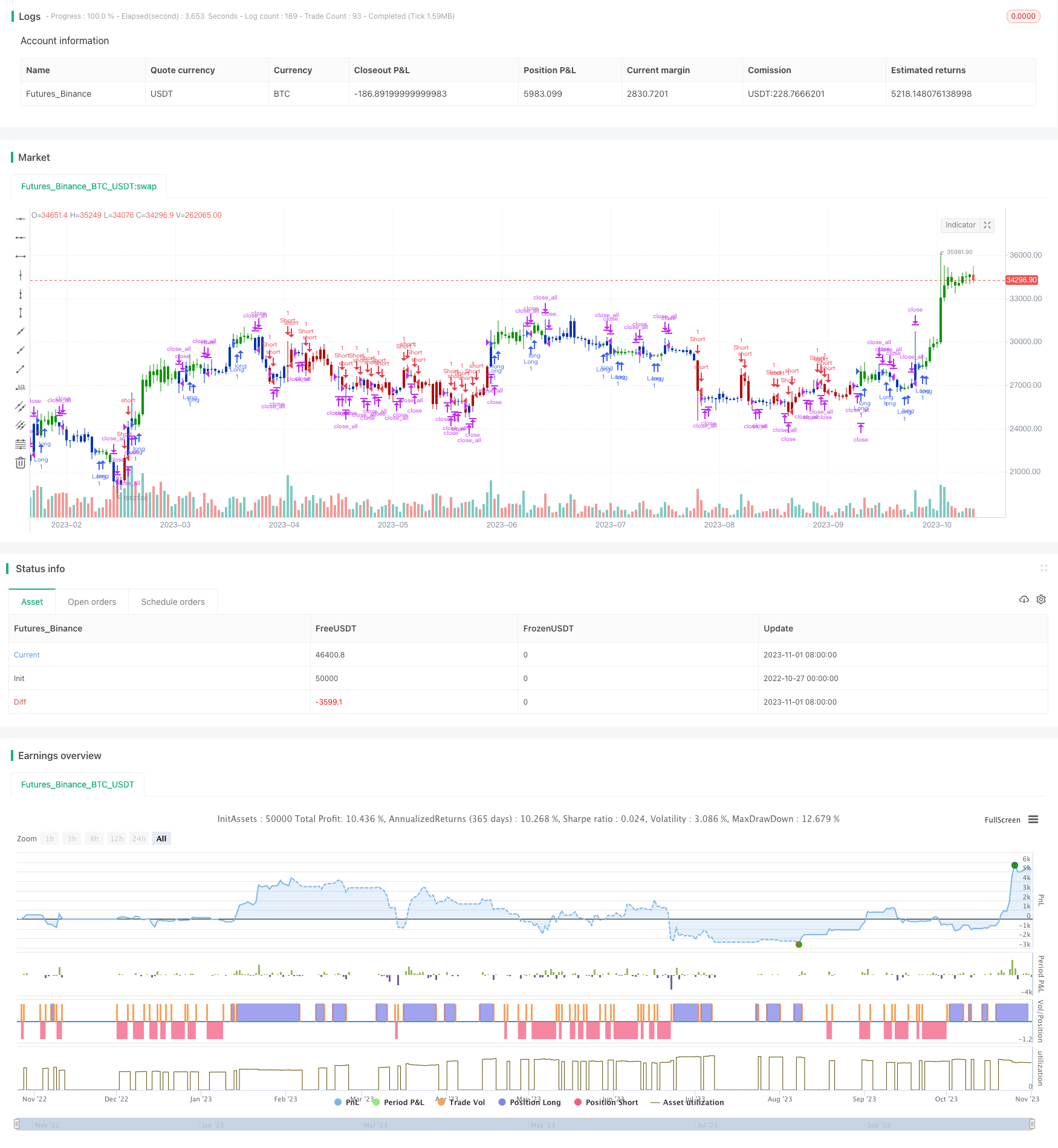
概述
这个策略使用2个指标来产生交易信号:2/20指数移动均线和平均真实波动范围反转指标。它结合了趋势跟随和短期反转两大策略思想,旨在发现反转机会。
原理
该策略由2部分组成:
2/20指数移动均线。它计算最近20天的指数移动均线,当价格从上穿下或从下穿上移动均线时,产生交易信号。
平均真实波动范围反转指标。它基于价格的平均真实波动范围计算停损位,当价格突破该停损位时,产生信号。这里使用的是3.5倍ATR作为止损位。
这个策略整合了两者信号。当2/20EMA产生多头信号而ATR反转产生空头信号的时候,做空;当2/20EMA产生空头信号而ATR反转产生多头信号的时候,做多。
优势分析
这个策略结合了趋势跟随和反转两大思路,旨在发现价格反转的机会。具体优势有:
2/20EMA能识别中期趋势,避免被市场噪音误导。
ATR反转指标能捕捉短期价格反转,把握反转机会。
结合两者信号,能在中期趋势发生转折的时候提前捕捉,从而提高获利概率。
ATR止损位设置比较合理,有一定的风险控制效果。
可自定义ATR倍数,适应不同品种特性。
可选择正向或反向交易,适用于不同行情环境。
风险分析
该策略也存在以下风险:
2/20EMA parameter较慢,可能错过短线机会。
ATR止损容易被突破打出,应适当宽松止损位。
单一指标易产生错误信号,应结合更多因素过滤。
需留意交易次数,防止过于频繁交易。
需进行参数优化和回测,确认适合该品种。
需严格遵守资金管理,控制单笔风险。
优化方向
该策略可从以下方面进行优化:
调整EMA参数,寻找最佳参数组合
优化ATR倍数大小,平衡止损幅度
增加过滤条件,结合换手率、波动率等指标
增加资金管理模块,动态调整仓位
增加止损策略,如Chandelier Exit
测试不同品种参数效果,找到最佳组合
加入机器学习模型,利用大数据提升表现
组合多个子策略,发掘更多Alpha
总结
该策略整合两大思路,具有一定的捕捉价格反转的能力。但也存在parameter选取不当带来的风险。可以从优化止损策略、增加过滤条件等方面进一步提升策略稳定性和盈利能力。
/*backtest
start: 2022-10-27 00:00:00
end: 2023-11-02 00:00:00
period: 1d
basePeriod: 1h
exchanges: [{"eid":"Futures_Binance","currency":"BTC_USDT"}]
*/
//@version=5
////////////////////////////////////////////////////////////
// Copyright by HPotter v1.0 05/04/2022
// This is combo strategies for get a cumulative signal.
//
// First strategy
// This indicator plots 2/20 exponential moving average. For the Mov
// Avg X 2/20 Indicator, the EMA bar will be painted when the Alert criteria is met.
//
// Second strategy
// Average True Range Trailing Stops Strategy, by Sylvain Vervoort
// The related article is copyrighted material from Stocks & Commodities Jun 2009
// Please, use it only for learning or paper trading. Do not for real trading.
//
//
// WARNING:
// - For purpose educate only
// - This script to change bars colors.
////////////////////////////////////////////////////////////
EMA20(Length) =>
pos = 0.0
xPrice = close
xXA = ta.ema(xPrice, Length)
nHH = math.max(high, high[1])
nLL = math.min(low, low[1])
nXS = nLL > xXA or nHH < xXA ? nLL : nHH
iff_1 = nXS < close[1] ? 1 : nz(pos[1], 0)
pos := nXS > close[1] ? -1 : iff_1
pos
ATRR(nATRPeriod,nATRMultip) =>
pos = 0.0
xATR = ta.atr(nATRPeriod)
nLoss = nATRMultip * xATR
xATRTrailingStop = 0.0
xATRTrailingStop := close > nz(xATRTrailingStop[1], 0) and close[1] > nz(xATRTrailingStop[1], 0) ? math.max(nz(xATRTrailingStop[1]), close - nLoss) :
close < nz(xATRTrailingStop[1], 0) and close[1] < nz(xATRTrailingStop[1], 0) ? math.min(nz(xATRTrailingStop[1]), close + nLoss) :
close > nz(xATRTrailingStop[1], 0) ? close - nLoss : close + nLoss
pos:= close[1] < nz(xATRTrailingStop[1], 0) and close > nz(xATRTrailingStop[1], 0) ? 1 :
close[1] > nz(xATRTrailingStop[1], 0) and close < nz(xATRTrailingStop[1], 0) ? -1 : nz(pos[1], 0)
pos
strategy(title='Combo 2/20 EMA & Average True Range Reversed', shorttitle='Combo', overlay=true)
var I1 = '●═════ 2/20 EMA ═════●'
Length = input.int(14, minval=1, group=I1)
var I2 = '●═════ Average True Range Reversed ═════●'
nATRPeriod = input.int(5, group=I2)
nATRMultip = input.float(3.5, group=I2)
var misc = '●═════ MISC ═════●'
reverse = input.bool(false, title='Trade reverse', group=misc)
var timePeriodHeader = '●═════ Time Start ═════●'
d = input.int(1, title='From Day', minval=1, maxval=31, group=timePeriodHeader)
m = input.int(1, title='From Month', minval=1, maxval=12, group=timePeriodHeader)
y = input.int(2005, title='From Year', minval=0, group=timePeriodHeader)
StartTrade = time > timestamp(y, m, d, 00, 00) ? true : false
posEMA20 = EMA20(Length)
prePosATRR = ATRR(nATRPeriod,nATRMultip)
iff_1 = posEMA20 == -1 and prePosATRR == -1 and StartTrade ? -1 : 0
pos = posEMA20 == 1 and prePosATRR == 1 and StartTrade ? 1 : iff_1
iff_2 = reverse and pos == -1 ? 1 : pos
possig = reverse and pos == 1 ? -1 : iff_2
if possig == 1
strategy.entry('Long', strategy.long)
if possig == -1
strategy.entry('Short', strategy.short)
if possig == 0
strategy.close_all()
barcolor(possig == -1 ? #b50404 : possig == 1 ? #079605 : #0536b3)